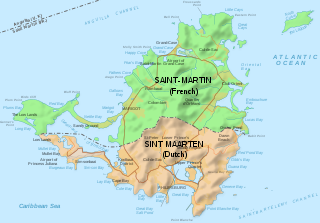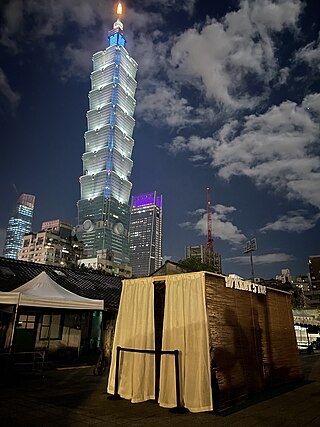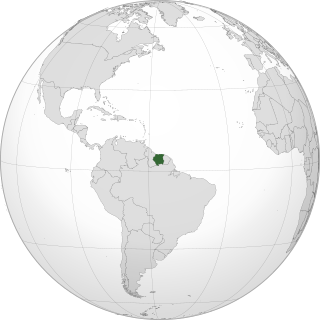Related Research Articles

Saint Martin is an island in the northeast Caribbean, approximately 300 km (190 mi) east of Puerto Rico. The 87-square-kilometre (34 sq mi) island is divided roughly 60:40 between the French Republic and the Kingdom of the Netherlands, but the Dutch part is more populated than the French part. The division dates to 1648. The northern French part comprises the Collectivity of Saint Martin and is an overseas collectivity of the French Republic. The southern Dutch part comprises Sint Maarten and is one of four constituent countries that form the Kingdom of the Netherlands. Even though the island is an overseas possession of two European Union member states, only the French part of the island is part of the EU.

Chabad, also known as Lubavitch, Habad and Chabad-Lubavitch, is an Orthodox Jewish Hasidic dynasty. Chabad is one of the world's best-known Hasidic movements. It is one of the largest Hasidic groups as well as one of the largest Jewish religious organizations in the world. Unlike most Haredi groups, which are self-segregating, Chabad mainly operates in the wider world and it caters to secularized Jews.

Sint Eustatius, known locally as Statia, is an island in the Caribbean. It is a special municipality of the Netherlands.

Jodensavanne was a Jewish plantation community in Suriname, South America, and was for a time the centre of Jewish life in the colony. It was established in the 1600s by Sephardi Jews and became more developed and wealthy after a group of Jews fleeing persecution in Brazil settled there in the 1660s. It was located in what is now Para District, about 50 km (31 mi) south of the capital Paramaribo, on the Suriname River. Sugarcane plantations were established by forcing Black African people to work as slaves. At its height in around 1700, Jodensavanne was home to roughly 500 plantation owners and 9000 enslaved people. The colony faced regular attacks from Indigenous people, slave revolts, and even raids from the French navy. The community eventually relocated to the capital of Paramaribo. Clearing of grave sites and maintenance of the synagogue ruins has been attempted at various times from the 1940s to the 21st century.

Philipsburg is the main town and capital of Sint Maarten, a constituent country of the Kingdom of the Netherlands. The town is on a narrow stretch of land between Great Bay and the Great Salt Pond. It functions as the commercial center of Saint Martin island, whereof Sint Maarten encompasses the southern half. As of 2017, it had 1,894 inhabitants.

The history of the Jews in Malta spans two millennia. A Jewish community is attested on the islands by the 4th-5th century. Jews prospered in Malta under Arab and Norman rule. They were expelled in 1492, and a community could only re-establish itself after 1798 under British rule. In the 19th and 20th century, the Jewish community in Malta welcomed refugees from Italy and Central Europe, escaping Nazi rule. Today, a small community remains well established on the islands.

Sint Maarten is a constituent country of the Kingdom of the Netherlands in the Caribbean region of North America. With a population of 41,486 as of January 2019 on an area of 34 km2 (13 sq mi), it encompasses the southern 44% of the divided island of Saint Martin, while the northern 56% of the island constitutes the French overseas collectivity of Saint Martin. Sint Maarten's capital is Philipsburg. Collectively, Sint Maarten and the other Dutch islands in the Caribbean are often called the Dutch Caribbean.

Jews in Taiwan, also known as Taiwanese Jews, comprise the Jewish community residing in Taiwan, a country located in East Asia. While the Jewish population in Taiwan is relatively small compared to other communities around the world, it has a rich and diverse history that spans several decades. The first sizable presence began in the 1950s, when religious services were held in the United States military chapel, to which civilians also had access.
The history of the Jews in the United Arab Emirates describes the historical and modern presence of Jews over the millennia in the Middle East and the recorded meetings with Jewish communities in areas that are today in the geographic territories of the United Arab Emirates.
The history of the Jews in Jamaica predominantly dates back to migrants from Spain and Portugal. Starting in 1509, many Jews began fleeing from Spain because of the persecution of the Holy Inquisition. When the English captured Jamaica from Spain in 1655, the Jews who were living as conversos began to practice Judaism openly. By 1611, the Island of Jamaica had reached an estimated population of 1,500 people. An estimated 75 of those people were described as "foreigners," which may have included some Portuguese Jews. Many Jamaican Jews were involved in the Atlantic slave trade, both owning and trading in enslaved Black people.
The Jodenbuurt is a neighbourhood of Amsterdam, Netherlands. For centuries before World War II, it was the center of the Dutch Jews of Amsterdam — hence, its name. It is best known as the birthplace of Baruch Spinoza, the home of Rembrandt, and the Jewish ghetto of Nazi occupation of the Netherlands.

Sint Maarten, a country within the Kingdom of the Netherlands, started issuing postal stamps after the dissolution of the Netherlands Antilles on 10 October 2010. The island thus became one of the five postage regions in the Kingdom of the Netherlands. The first stamp issued showed the map of the island Saint Martin.

The history of the Jews in Suriname starts in 1639, as the English government allowed Spanish and Portuguese Jews from the Netherlands, Portugal and Italy to settle the region, coming to the old capital Torarica.

The history of the Jews in the Democratic Republic of the Congo can be traced back to 1907, when the first Jewish immigrants began to arrive in the country. The current Jewish Congolese population is mostly of Sephardi background.
The history of the Jews in Curaçao can be traced back to the mid-17th century, when the first Jewish immigrants began to arrive. The first Jews in Curaçao were Sephardi Jewish immigrants from the Netherlands, Portugal, and Spain. These immigrants founded Congregation Mikvé Israel-Emanuel, the oldest continuously used synagogue in the Americas. The first Jew to settle in Curaçao was a Dutch-Jewish interpreter named Samuel Cohen, who arrived on board a Dutch fleet in 1634. By the mid-1700s, the community was the most prosperous in the Americas and many of the Jewish communities in Latin America, primarily in Colombia and Venezuela, resulted from the influx of Curaçaoan Jews.

The Jewish community of Houston, Texas has grown and thrived since the 1800s. As of 2008, Jews lived in many Houston neighborhoods and Meyerland is the center of the Jewish community in the area.

The unification of Saint Martin is the proposed unification of the small island of Saint Martin, located in the Caribbean Sea. Currently, it is divided into Sint Maarten and the Collectivity of Saint Martin. The island has been divided since the signing of the Treaty of Concordia in 1648, which today remains as one of the oldest treaties still in effect.
Black Jews in New York City comprise one of the largest communities of Black Jews in the United States. Black Jews have lived in New York City since colonial times, with organized Black-Jewish and Black Hebrew Israelite communities emerging during the early 20th century. Black Jewish and Black Hebrew Israelite communities have historically been centered in Harlem, Brooklyn, The Bronx, and Queens. The Commandment Keepers movement originated in Harlem, while the Black Orthodox Jewish community is centered in Brooklyn. New York City is home to four historically Black synagogues with roots in the Black Hebrew Israelite community. A small Beta Israel (Ethiopian-Jewish) community also exists in New York City, many of whom emigrated from Israel. Black Hebrew Israelites are not considered Jewish by the New York Board of Rabbis, an organization representing mainstream Rabbinic Judaism. However, some Black Hebrew Israelite individuals in New York City are recognized as Jewish due to converting through the Orthodox, Conservative, or other Jewish movements.
The city of Frederick, Maryland is home to a small but growing Jewish community. With roots dating to the colonial era, Frederick's Jewish community is home to three synagogues, a Hebrew school, and a Jewish community center.

The Jewish cemetery in Hoorn can refer to the original Jewish cemetery on the outskirts of the Dutch city of Hoorn, or to a separate section of today's public cemetery. That Jewish section was opened in 1968, after the old Jewish cemetery was cleared for road construction.
References
- 1 2 Bremmer, Marius (November 10, 2006). "David droomt van sjoel en rustplaats". Trouw . Amsterdam: DPG Media . Retrieved April 29, 2020.
In 1735 vestigt zich de eerste Sefardische Jood op Sint Maarten: Jacob Gomes, een man met vier slaven. In de 18de eeuw – voornamelijk vanwege wapenhandel rond de Amerikaanse Vrijheidsoorlog – stijgt het aantal Joden, daarna vertrekken de meesten weer. De Robles: 'Downtown staat nog de ruïne van hun kleine synagoge, gebouwd van heuse Hollandse ijsselsteen. Tijdens bouwwerkzaamheden in de jaren zeventig van de vorige eeuw vond men grafresten bij een steeg, die in de volksmond "Jewish Cemetary[ sic ] Alley" heette, de joodse begrafenisstraat. De beenderen die ze er vonden, gaven ze met de vuilnisman mee.'
- ↑ Johnson, Will (June 29, 2016). "The Jews in the Dutch West Indies". The Saba Islander. Retrieved April 29, 2020.
In 1735 a Jacob Gomes lived there with his four slaves; besides him the widow Silva with her son and daughter. Already in 1783 there was an organized Jewish community, considering that their Parnassim in that year requested legalization from the West India Company. A synagogue was built on the 'East end of the Back Street on the South Side.' M.D. Teenstra [visited] around 1828 the ruins of the building. The Jewish population declined since the end of the 18th century.
- 1 2 3 Weiss, Steven; Weiss, Beth (January 3, 2019). "Jewish History of St Maarten". Jerusalem: Shavei Israel . Retrieved April 29, 2020.
- 1 2 Conn, Stephen (25 February 1990). "St. Martin's Jewish community, in search of a rabbi". The Washington Post . Retrieved May 1, 2020.
Tourists and residents alike know of yet another myth, namely the Jewish cemetery where Jews from an earlier era supposedly lie at rest. Those who claim that such a cemetery exists say that Joodsche Kerkhof Straat in Philipsburg was named for the burial ground. Yet no one knows exactly where the street is. [...] When Julio Meit came to St. Martin from Curacao on Jan. 1, 1964, with his wife, Ruth, and son, Moshe, the Meits became the first Jewish family to live in St. Martin in 200 [sic] years.
- 1 2 Groen, J.A. (1854). Handleiding bij de Christelijke Zendingskaart [Guide to the Christian Mission Map] (in Dutch). Vol. 1. Leiden: J.H. Zitman. p. 337.
In het Nederl. gedeelte van dit eiland worden 1235 vrijen en 1626 slaven aangetroffen, onder welke zich 125 R. Kathol., 1095 vrije Protest. en 3 Joden bevinden. [In the Dutch part of this island 1235 freedmen and 1626 slaves can be found, among whom 125 are Roman Catholics, 1095 free Protestants and 3 Jews.]
- ↑ Fridman, S. (August 17, 2009). "First Chabad House Opens in St. Martin/St. Maarten; Chabad Couple Leaves For St. Martin Today". Chabad Lubavitch Headquarters. New York City . Retrieved May 1, 2020.
- ↑ Huriash, Lisa (March 11, 2013). "Broward team helps crack Jewish mystery in St. Maarten". Sun Sentinel . Retrieved May 1, 2020.